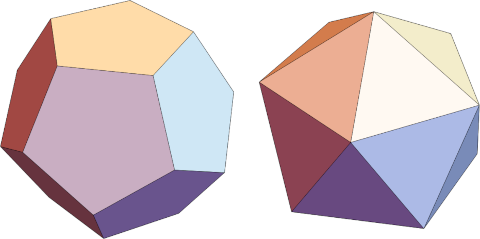Roundest regular solid

Iconjack posted on X today
(Possibly) surprising fact: a regular dodecahedron is rounder than a regular icosahedron.
You might reasonably suppose that having more sides would result in a rounder figure, so a figure with 20 sides should be rounder than a figure with 12 sides. But it's the other way around.
Discrete curvatureHere's one way to see the statement above. In a dodecahedron, three pentagons come together at each vertex. The interior angles of a pentagon have 108. If you were to take the three pentagons, cut a slit long one slide, and push them flat on to a plane, there would be a gap of
360 - 3 * 108 = 36.
This gap is known as theangle defect and is the discrete analog of curvature.
In an icosahedron you have five triangles coming together at a point. So if you were to push the five triangles at a vertex down to a point, there would be a gap (angle defect) of
360 - 5 * 60 = 60.
The larger angle defect means the shape is less round at a vertex.
For completeness, the angle defect of a cube is 90. For an octahedron it's 120 and for a tetrahedron it's 180.
Dihedral anglesAngle defect is the standard way to measure how round a polyhedron is. It focuses on how faces fit together at a vertex. But we could instead focus on how faces fit together at an edge. The angle between two adjacent faces is the dihedral angle.
The faces of an icosahedron come meet at an angle of approximately 138.19. For a dodecahedron, the angle is 116.57. So the icosahedron is rounder in the sense that the faces come together at an angle closer to 180.
The dihedral angles for the octahedron, cube, and tetrahedron are 109.47, 90, and 70.53.
Related postsThe post Roundest regular solid first appeared on John D. Cook.